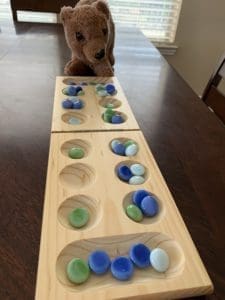
Mancala is one of the oldest strategy games in the world, and may have its origins in ancient Egypt or Ethiopia. Variations are played across many cultures including South Asia, Western Africa, the Caribbean, and Eastern Europe. It was brought to America by African slaves who had played as children. While different variations have different game boards and rules, the basic gameplay as commonly played today (and sold in commercial versions in the U.S.) is based on the version called Kalah and played as follows:
Basic game play rules for Mancala
Game play starts by placing four “seeds” in each of twelve pits, six pits on one side of the board and six on the other. When it is his turn a player picks up all the seeds in any one of the pits on his side of the board and places one seed in each of the next pits moving counter clockwise until he has placed them all. He may end up putting seeds in his opponent’s pits along the way but does not place in their store. If the last seed in his hand lands in his store he takes another turn. Also, if the last seed in his hand lands in an empty pit on his own side, he gets to capture all of the seeds in his opponent’s opposite pit. The game ends when one player’s pits are completely empty. The other player takes the seeds remaining in her pits and puts those seeds in her store. Count up the seeds. Whoever has the most seeds wins.
Skills Taught
Mancala is a strategy game that requires critical thinking. To play strategically requires counting seeds and planning moves as well as anticipating your opponent’s moves. For young children it is a good game for developing counting and subitizing skills. It also develops fine motor skills as students pick up the small pieces with their fingers and drop them one at a time. Finally I love modeling counting and multiplicative strategies as I count my seeds at the end. I generally place them in groups of 4 or 5 and build an array.

Making Your Own Mancala
While you can buy beautiful commercial mancala games, you can also make your own (or have students make their own.) You can make a game board easily from egg cartons or small paper cups, and use any kind of counter for the seeds- paper clips, coins, pompoms, marbles, colored pasta, small rocks, vase gems, raisins, goldfish crackers, M&Ms, and Skittles are just some of many possibilities.

This post from AuntAnnie.com tells you how to make a clay dough game board and also has rules for several variations of the game.
If you’re handy with woodworking and have a drill and a jigsaw, here are instructions for Easy DIY Wood Mancala
You could even just print and laminate a paper version, though that’s not nearly as much fun!
If you do want to buy one on Amazon here’s one link (there are many options!)
Virtual Mancala Strategy Game
- Mancala at Math Playground
- Mancala at Cool Math
- Dr Mike’s Math Games for Kids has options to vary the difficulty of the game (“how smart you want the computer to be”, how many holes per side, and how many seeds per hole)
For More Information
Using Mancala in the Mathematics Classroom journal article by the National Council of Teachers of Mathematics
Games For Young Minds has great information on questioning strategies to use with kids, and ways to play and develop mathematical thinking skills even with a 3 year old.
